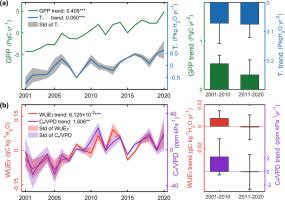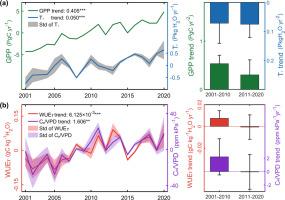2001 - 2020年全球植被水分利用效率格局与趋势
IF 5.7
1区 农林科学
Q1 AGRONOMY
引用次数: 0
摘要
本研究介绍了一种新的基于卫星的框架,该框架将太阳诱导的叶绿素荧光(SIF)与植物生理学理论结合起来,同时估算总初级生产力(GPP)和蒸腾(Tr)。该综合方法实现了2001 - 2020年植被水分利用效率(WUET = GPP/Tr)和生态系统水分利用效率(WUE = GPP/蒸散)的全球评估。利用通量塔数据进行的现场规模验证表明,WUE (R2 = 0.615)和WUET (R2 = 0.573)具有很强的一致性。在全球范围内,由于CO2施肥,WUET从2001年到2010年有所增加,但在2011年至2020年期间趋于稳定,因为蒸汽压赤字(VPD)的增加抵消了生理收益。与植被绿化相关的Tr/ET增加推动WUE持续上升(与LAI的R2 = 0.776)。归因分析表明,CO2和VPD共同解释了70%以上的WUET年际变化。使用CMIP6模型的未来预测表明,WUET将密切关注二氧化碳与VPD比值(Ca/VPD)的变化,而在高排放情景(SSP370和SSP585)下,由于CO2持续上升和lai驱动的Tr/ET增加,预计到2100年WUE将增加。这些结果强调了SIF在大规模碳水耦合评估中的实用性,并强调了在评估生态系统对气候变化的响应时联合考虑大气干燥和植被结构的必要性。本文章由计算机程序翻译,如有差异,请以英文原文为准。


Global patterns and trends of vegetation water use efficiency inferred from solar-induced chlorophyll fluorescence from 2001 to 2020
This study introduces a novel satellite-based framework that integrates solar-induced chlorophyll fluorescence (SIF) with plant physiological theory to simultaneously estimate gross primary productivity (GPP) and transpiration (Tr). This integrated approach enables global assessment of vegetation water use efficiency (WUET = GPP/Tr) and ecosystem water use efficiency (WUE = GPP/evapotranspiration) from 2001 to 2020. Site-scale validation using flux tower data shows strong agreement for WUE (R2 = 0.615) and WUET (R2 = 0.573). Globally, WUET increased from 2001 to 2010 due to CO2 fertilization but stabilized from 2011 to 2020 as rising vapor pressure deficit (VPD) offset physiological gains. In contrast, WUE continued to rise driven by increased Tr/ET linked to vegetation greening (R2 = 0.776 with LAI). Attribution analysis shows that CO2 and VPD together explained over 70 % of interannual variation in WUET. Future projections using CMIP6 models indicate that WUET will closely follow changes in the CO2-to-VPD ratio (Ca/VPD), while WUE is expected to increase through 2100 under high-emission scenarios (SSP370 and SSP585), supported by continued CO2 rise and LAI-driven increases in Tr/ET. These results highlight the utility of SIF for large-scale carbon–water coupling assessment and underscore the need to jointly consider atmospheric dryness and vegetation structure in evaluating ecosystem responses to climate change.
求助全文
通过发布文献求助,成功后即可免费获取论文全文。
去求助
来源期刊
CiteScore
10.30
自引率
9.70%
发文量
415
审稿时长
69 days
期刊介绍:
Agricultural and Forest Meteorology is an international journal for the publication of original articles and reviews on the inter-relationship between meteorology, agriculture, forestry, and natural ecosystems. Emphasis is on basic and applied scientific research relevant to practical problems in the field of plant and soil sciences, ecology and biogeochemistry as affected by weather as well as climate variability and change. Theoretical models should be tested against experimental data. Articles must appeal to an international audience. Special issues devoted to single topics are also published.
Typical topics include canopy micrometeorology (e.g. canopy radiation transfer, turbulence near the ground, evapotranspiration, energy balance, fluxes of trace gases), micrometeorological instrumentation (e.g., sensors for trace gases, flux measurement instruments, radiation measurement techniques), aerobiology (e.g. the dispersion of pollen, spores, insects and pesticides), biometeorology (e.g. the effect of weather and climate on plant distribution, crop yield, water-use efficiency, and plant phenology), forest-fire/weather interactions, and feedbacks from vegetation to weather and the climate system.

 求助内容:
求助内容: 应助结果提醒方式:
应助结果提醒方式:


